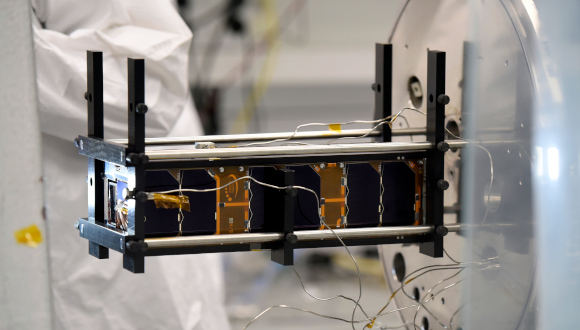TAU nanosatellite hitches a ride on a NASA rocket to the International Space Station on February 20

The nanosatellite, entirely designed and assembled on the University campus, will measure cosmic radiation around the earth
Support this researchThe TAU-SAT1 nanosatellite, approximately the size of a shoebox, will begin its travel to Earth’s orbit from Wallops Island, VA, on a NASA rocket on Saturday, February 20, 2021. The rocket will dock with the International Space Station (ISS) and astronauts will release the satellite into orbit from there.
The launch, scheduled for 12:36 p.m. Eastern time, will be broadcast publicly and available for livestreaming, preceded by a panel discussion about the satellite. The livestream will begin at 11:45 a.m. Eastern time on February 20 and will be available here.
Tel Aviv University (TAU) scientists are excited by the remarkable scientific and technological achievement, noting that the nanosatellite is the first to be wholly designed, developed, assembled and tested at an Israeli university. The work was done at TAU’s Center for Nanosatellites, an interdisciplinary endeavor between the Iby and Aladar Fleischman Faculty of Engineering and the Porter School of the Environment and Earth Sciences at the Raymond and Beverly Sackler Faculty of Exact Sciences and the Soreq Nuclear Research Center (SNRC).
TAU completed the construction of TAU-SAT1 about four months ago, sending it for pre-flight testing to the Japanese space agency JAXA. About two weeks ago, the nanosatellite arrived at its final stop prior to liftoff, Wallops Island — where it will “catch a ride” on a NASA resupply spacecraft destined for the International Space Station (ISS).
“It’s a big day for TAU,” says Professor Colin Price, Head of the Porter School. “We have now joined the ‘Civil Space Revolution,’ called New Space, in which, unlike the Old Space, not only giant companies with huge budgets and large teams of engineers can build and launch satellites. A few years ago we established the Center for Nanosatellites, with the goal to build small ‘CubeSats’ for research purposes. Since then we were able to prove that with the right planning, miniaturization and modulation of many technologies, small satellites can be built and launched into space within two years by students, at a fraction of the budget needed in the Old Space.”
“This is a nanosatellite, or miniature satellite, of the CubeSat variety,” explains Dr. Ofer Amrani, Head of TAU’s Miniature Satellite Lab. “The satellite’s dimensions are 4 by 4 by 12 inches (10 by 10 by 30 cm), and it weighs less than six pounds (2.5 kilograms). TAU-SAT1 is the first nanosatellite designed, built and tested independently in an Israeli university by researchers and students.”
Dr. Meir Ariel, Director of TAU’s Center for Nanosatellites, says, “We know that that there are high-energy particles moving through space that originate from the sun’s cosmic radiation. Our scientific task is to monitor this radiation, and to measure the flux of these particles and their products. It should be understood that space is a hostile environment, not only for humans but also for electronic systems. When these particles hit astronauts or electronic equipment in space, they can cause significant damage. The scientific information collected by our satellite will enable the design of protective means for astronauts and space systems. To this end, we incorporated into the satellite a number of experiments, developed by our partners at SNRC’s Space Environment Department, who will also conduct the relevant scientific research.”
Another challenge that presented itself was how to extract the data collected by the TAU-SAT1 satellite. At an altitude of 250 miles (400 kilometers) above sea level, the nanosatellite will orbit the earth at a dizzying speed of 17,000 miles per hour (27,600 kilometers per hour), or five miles per second (7.6 kilometers per second), completing a circuit around Earth every 90 minutes. “In order to collect data, we built a satellite station on the roof of the Engineering building,” says Dr. Amrani. “Our station, which also serves as an amateur radio station, includes a number of antennas and an automated control system.
“When TAU-SAT1 passes ‘over’ Israel, that is, within a radius of a few thousand kilometers from the ground station’s receiving range, the antennas will track the satellite’s orbit and a process of data transmission will occur between the satellite and the station. Such transmissions will take place about four times a day, with each one lasting less than 10 minutes. In addition to its scientific mission, the satellite will also serve as a space relay station for amateur radio communities around the world.
“In total, the satellite is expected to be active for several months. Because it has no engine, its trajectory will fade over time as a result of atmospheric drag — and eventually it will burn up in the atmosphere and come back to us as stardust.”
TAU researchers are already aiming for their next target, TAU-SAT2. “We built the infrastructure for developing TAU-SAT1 on our own — from the cleanrooms, through the various testing facilities such as the thermal vacuum chamber, to the receiving and transmission station we placed on the roof,” Dr. Amrani says. “Now that the infrastructure is ready, we can begin to develop TAU-SAT2. The idea is that any researcher and any student, from any school at TAU, or outside of it, will be able to plan and launch experiments into space in the future — even without being an expert on space.”